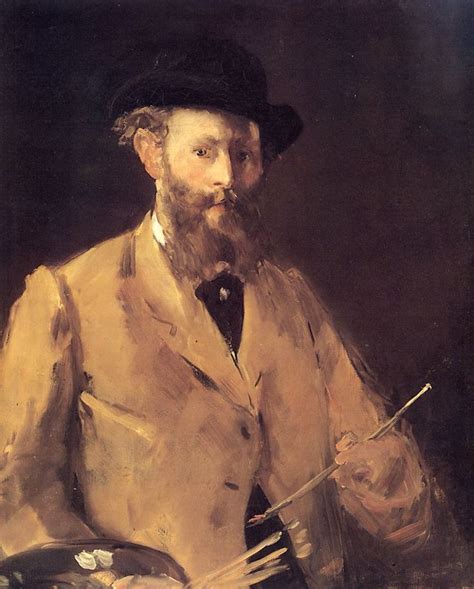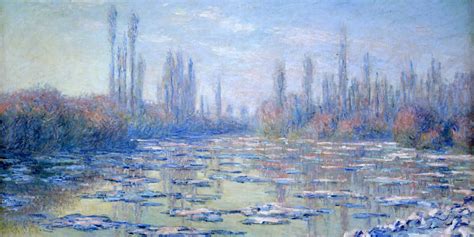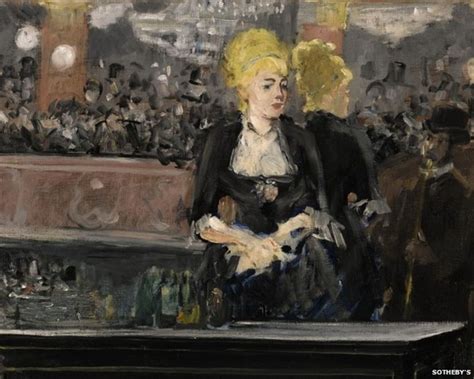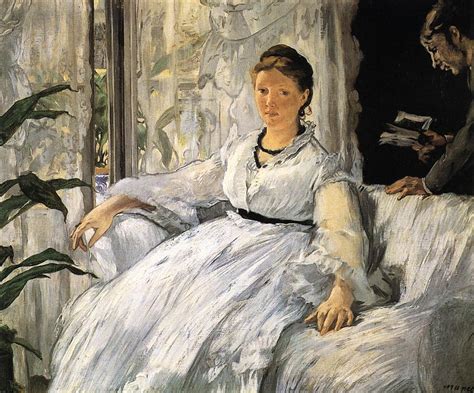When one thinks of the most influential painters in history, Édouard Manet undoubtedly comes to mind. Born in 1832 in France, Manet redefined the concept of art during his brief but impactful life. Through his unique style and unconventional approach, he challenged the traditional norms of the art world, leaving a lasting legacy that continues to inspire and captivate.
Manet's artistry was characterized by his ability to capture the essence of his subjects with a raw and unfiltered perspective. He had a keen eye for detail, and his brushstrokes effortlessly conveyed emotions, narratives, and social commentary. With a natural instinct for composition and color, Manet's works were often bold and provocative, forcing viewers to question the societal conventions of his time.
Known for his rebellious spirit, Manet was not afraid to challenge the status quo. His refusal to conform to the established art institutions of his era brought him both praise and criticism in equal measure. In an era dominated by romanticism and realism, Manet carved his own path, blending elements of both styles while injecting his unique vision into every piece.
Throughout his career, Manet produced a vast body of work that covered a wide range of subjects, from captivating portraits of friends and family members to scenes depicting everyday life in 19th-century France. His art not only celebrated the beauty of the human form but also delved into the complexities of modern society, addressing issues such as class, gender, and political power.
Today, Édouard Manet's influence reverberates through the art world, continuing to inspire countless artists and viewers alike. His innovative techniques and bold choices laid the groundwork for the development of modern art movements such as impressionism and symbolism. Manet's legacy is not only a testament to his immense talent but also a reminder of the power of art to challenge conventions and shape the course of history.
Join us as we delve into the life, art, and lasting impact of Édouard Manet, shedding light on the man behind the brushstrokes and exploring the intricate beauty and significance of his masterpieces.
Early Life and Impactful Career

Édouard Manet, a renowned and influential figure in the world of art, left an indelible mark on the art scene of 19th century France. The brilliance of his work transcended boundaries and challenged conventional notions of artistry during his time. With an inherent talent for capturing the essence of everyday life, Manet's paintings were a reflection of the changing social and cultural dynamics of the era.
Manet's ability to incite contemplation and evoke emotions through his brushstrokes and choice of subjects resonated with viewers on a profound level. His unconventional techniques and bold experimentation with color, composition, and subject matter set him apart from his contemporaries and laid the foundation for artistic movements that followed.
Embracing the notion that art is a reflection of society, Manet delved into themes that were previously considered taboo, challenging the status quo and igniting debates on their societal implications. His penchant for incorporating contemporary elements into his paintings, such as industrialization and urbanization, further solidified his position as a trailblazer and a catalyst for change.
Manet's impact reached far beyond the boundaries of the art world. His refusal to conform to established norms inspired future generations of artists to embrace their individuality and strive for artistic freedom.
The legacy of Édouard Manet endures, as his groundbreaking contributions continue to inspire and captivate audiences around the world. By daring to push boundaries and challenge societal norms, he forever changed the course of art history, leaving an indelible footprint that will continue to shape the art world for generations to come.
Early Life and Education
Exploring the formative years and academic journey of Édouard Manet.
Embarking on a voyage through the early life and educational pursuits of Édouard Manet allows us to delve into the foundation that shaped his illustrious career as a revered artist. Born in 1832 in France, Manet's upbringing and educational experiences acted as vital catalysts in his artistic development.
During his formative years, Manet displayed an innate curiosity and a profound appreciation for the world around him, sparking a deep passion for artistic expression. His educational journey began with a traditional academic upbringing, which laid the groundwork for his future artistic endeavors.
Immersed in the rich cultural milieu of Paris, Manet found himself captivated by the vibrant art scene that embraced a diverse range of styles and techniques. His exposure to various art forms during this period greatly influenced his artistic sensibilities, fueling his ambition to become a painter.
Manet's formal education in the arts commenced at the prestigious École des Beaux-Arts, where he honed his technical skills and absorbed the various artistic theories of the time. However, he soon grew dissatisfied with the rigid academic approach and sought to challenge conventional norms through his innovative style.
As Manet matured, his artistic voice grew more distinct, reflecting his rebellious spirit and his desire to break free from the constraints of traditional art. His exploration of new techniques and subject matters showcased his ability to push boundaries, establishing him as a leading figure in the avant-garde art movement.
The early life and education of Édouard Manet laid the groundwork for his revolutionary artistic career, showcasing his unwavering dedication to his craft and his refusal to conform to established norms. These crucial formative years shaped his distinctive style, ensuring his lasting impact on the art world.
Manet's Style and Artistic Innovations

Manet was a pioneering artist who revolutionized the world of art in the 19th century. He is renowned for his distinctive style and innovative approach, which broke away from the traditional norms of the time.
One of the key aspects of Manet's style was his ability to capture the essence and vitality of modern life. His paintings often depicted scenes from everyday urban life, showcasing the bustling streets, cafes, and leisure activities that characterized Paris during the time. Through his unique perspective, Manet provided a fresh and honest portrayal of society, challenging the established notions of beauty and aesthetics.
Another significant innovation of Manet was his brushwork and use of color. He abandoned the traditional smooth and blended brushstrokes, opting for bold and loose strokes that emphasized the texture and materiality of the paint. This technique gave a sense of immediacy to his works, infusing them with energy and dynamism.
Manet's artistic innovations were also evident in his composition and framing. He often cropped his subjects, placing them at the edge of the canvas or breaking the traditional rules of perspective. This allowed him to create unconventional compositions that challenged the viewer's perception and invited them to actively engage with the artwork.
Furthermore, Manet's choice of subjects was unconventional for his time. He depicted scenes that were considered controversial or socially taboo, such as his famous painting "Olympia," which portrayed a nude female figure in a confrontational manner. By choosing such subjects, Manet confronted societal norms and sparked debates on topics of sexuality, gender, and power.
Overall, Manet's style and artistic innovations played a crucial role in shaping the course of modern art. His bold brushwork, unconventional compositions, and daring subject matter were instrumental in paving the way for the artistic movements that followed, such as Impressionism and Post-Impressionism. Manet's influence remains evident in the works of countless artists who continue to be inspired by his revolutionary approach to art.
Controversial Works and Public Reception
One aspect of Édouard Manet's artistic career that sparked widespread debate and controversy was his daring and unconventional approach to painting. His works challenged traditional artistic conventions and often pushed the boundaries of what was considered acceptable in the art world of his time.
Manet's artistic style, characterized by bold brushstrokes, flattened perspectives, and an emphasis on everyday subjects, stood in stark contrast to the prevailing academic standards of the 19th century. His unconventional depiction of nude figures, unconventional compositions, and controversial subject matters often garnered strong reactions from both the public and the art establishment.
Many of Manet's paintings, such as "Olympia" and "Le Déjeuner sur l'herbe," stirred controversy for their direct and unapologetic portrayals of sexuality and nudity. These works challenged societal norms and provoked heated debates on the boundaries of art and decency. Critics and traditionalists were quick to condemn Manet's works as vulgar and morally objectionable.
Despite the controversies surrounding his paintings, Manet managed to attract a select group of admirers and supporters who recognized the artist's innovative vision and appreciated his willingness to challenge the status quo. Artists such as Claude Monet, Edgar Degas, and Henri Fantin-Latour admired Manet's artistic courage and viewed him as a leader of the avant-garde movement.
Over time, as the art world evolved and embraced new forms of expression, Manet's controversial works came to be recognized as groundbreaking and influential. His paintings paved the way for the emergence of modern art movements such as Impressionism and Realism, and his willingness to defy artistic conventions marked him as a pioneer in the art world.
- Manet's controversial works challenged traditional artistic conventions.
- His bold brushstrokes and unconventional compositions stirred debate.
- "Olympia" and "Le Déjeuner sur l'herbe" drew criticism for their explicit subjects.
- Despite the controversies, Manet had a group of supporters who recognized his artistic vision.
- Eventually, Manet's controversial works became recognized as influential and groundbreaking.
Influence on the Impressionist Movement

In the realm of art history, the impact of Édouard Manet on the development of Impressionism cannot be overstated. His innovative style and radical departure from traditional techniques and subjects laid the groundwork for the emergence of one of the most influential art movements of the 19th century.
Manet's groundbreaking approach to painting challenged the established norms of the time. Through his use of bold brushwork, vibrant colors, and unconventional composition, he sought to capture the fleeting moments of modern life with a sense of immediacy and authenticity. His emphasis on the subjective perception of the artist and the depiction of light and color paved the way for the Impressionists' exploration of these same themes.
Manet's influence on the Impressionists extended beyond purely technical aspects. His choice of subject matter, often focused on contemporary scenes and ordinary people, challenged the traditional hierarchy of artistic themes. By elevating seemingly mundane subjects to the level of high art, Manet paved the way for the Impressionists' celebration of everyday life and rejection of academic conventions.
Manet's role as a mentor and advocate for the younger generation of artists was also pivotal in shaping the direction of Impressionism. His support and encouragement of painters such as Claude Monet, Pierre-Auguste Renoir, and Berthe Morisot provided a crucial platform for the development and recognition of their work.
In conclusion, Édouard Manet's groundbreaking techniques, unconventional subject matter, and mentorship of the next generation of artists played a fundamental role in the emergence and evolution of Impressionism. His impact on the movement extended beyond his own lifetime and continues to resonate in the art world to this day.
Relationship with the Salon and the Academy
Throughout his career, Édouard Manet had a complex relationship with the Salon and the Academy, two dominant institutions in the art world of 19th-century France.
The Salon, an annual art exhibition held in Paris, played a crucial role in shaping artistic tastes and trends. However, Manet's innovative and controversial style often clashed with the conservative standards upheld by the Salon. His refusal to conform to traditional artistic conventions, such as the use of idealized subjects and smooth brushwork, led to his work being rejected from the Salon on multiple occasions.
Despite facing rejection from the Salon, Manet did not give up on his artistic ambitions. He sought alternative ways to showcase his work and connect with fellow artists and art enthusiasts. One such avenue was the Salon des Refusés, an exhibition organized by the Academy in response to the increasing number of artists whose works were rejected by the official Salon. Manet's inclusion in the Salon des Refusés in 1863 brought him both recognition and controversy, with his painting "Le déjeuner sur l'herbe" sparking a scandal due to its unconventional subject matter and artistic treatment.
Manet's relationship with the Academy was also marked by resistance and rebellion. The Academy, renowned for its strict adherence to traditional artistic techniques and themes, viewed Manet's work as a threat to the established order. Despite this opposition, Manet remained committed to forging his own path and challenging the status quo.
Ultimately, Manet's revolutionary approach to painting and his refusal to conform to the dictates of the Salon and the Academy played a significant role in shaping the course of art history. His boldness and determination paved the way for future generations of artists to break free from conventional norms and explore new artistic possibilities.
Manet's Connection to the Parisian Avant-Garde

One of the most significant aspects of Édouard Manet's career was his deep connection to the avant-garde movement in Paris. Through his provocative and innovative artworks, he became a prominent figure within this vibrant artistic community, challenging traditional artistic conventions and pushing boundaries.
Manet's association with the Parisian avant-garde was marked by his close friendships and collaborations with fellow artists, writers, and thinkers who shared his progressive ideas. He was a regular participant in the famous gatherings at Café Guerbois, where he exchanged ideas and engaged in lively discussions with other avant-garde figures.
Unlike many of his contemporaries, Manet did not conform to the established rules and norms of the art world. Instead, he embraced a rebellious spirit and dared to challenge conventional notions of beauty, subject matter, and technique. His works, such as "Olympia" and "Le Déjeuner sur l'herbe," caused controversy and sparked intense debates within the artistic community.
Manet's connection to the Parisian avant-garde extended beyond his own artistic practice. He actively supported and championed the work of other avant-garde artists, often exhibiting alongside them in groundbreaking group exhibitions. Through his participation in these exhibitions, Manet helped to establish the avant-garde movement as a force to be reckoned with in the art world, paving the way for future generations of artists.
Furthermore, Manet's influence on the avant-garde went beyond his lifetime. His bold and daring approach to painting inspired countless artists who came after him, shaping the course of modern art. The avant-garde movement owes a great debt to Manet's visionary contributions, as he challenged conventions, pushed boundaries, and paved the way for artistic experimentation.
- Manet's close friendships and collaborations within the Parisian avant-garde
- His rejection of traditional artistic conventions
- The controversy and debates surrounding his unconventional works
- His support of other avant-garde artists and participation in groundbreaking exhibitions
- The lasting influence of Manet on the avant-garde movement and modern art
Legacy and Impact on Modern Art
Édouard Manet's contributions to the art world have left a lasting impact on the evolution of modern art. His innovative techniques and revolutionary approach challenged the traditional norms of his time, paving the way for future artists to explore new artistic possibilities.
One of the key legacies of Manet's work is his role in the birth of Impressionism. While not considered a true Impressionist himself, his rejection of academic standards and emphasis on capturing fleeting moments and natural lighting set the stage for the movement's rise. Manet's loose brushwork and bold use of color influenced artists such as Monet and Renoir, who would later become the leading figures of Impressionism.
Manet's portrayal of modern life and social realism also had a profound impact on modern art. By depicting contemporary subjects and addressing social issues, he challenged the traditional hierarchy of subject matters in art. His unflinching portrayal of everyday people and scenes foreshadowed the emergence of Realism and paved the way for later movements such as Social Realism and the Ashcan School.
Furthermore, Manet's exploration of the relationship between painting and photography contributed to the development of modern art. His use of cropped compositions and unconventional perspectives was reminiscent of the framing techniques used in photography. This blurring of boundaries between the two mediums inspired artists to experiment with unconventional compositions and new ways of seeing.
Manet's influence extends beyond his own time and continues to inspire contemporary artists. His boldness in challenging artistic conventions, his commitment to depicting modern life, and his innovative techniques make him a seminal figure in the history of modern art.
Popular Artworks by Édouard Manet

In this section, we will explore some of the most well-known and celebrated artworks created by the influential French painter, Édouard Manet. These works showcase Manet's mastery of technique, his unique perspective, and his ability to challenge traditional artistic norms.
Olympia
One of Manet's most iconic paintings, Olympia, caused quite a stir when it was first exhibited in 1865. This bold and provocative portrait depicts a reclining nude woman staring directly at the viewer, challenging the viewer's gaze and subverting the conventions of female representation in art. The painting's unconventional composition and confident brushwork exemplify Manet's rejection of traditional academic painting.
A Bar at the Folies-Bergère
In this masterpiece, Manet captures the bustling atmosphere of a Parisian bar in the late 19th century. The painting depicts a barmaid behind a counter, with a mirror reflecting the lively scene. Through the use of perspective and symbolism, Manet invites viewers to question the nature of reality and the role of the observer. The painting's composition and attention to detail highlight Manet's innovative approach to capturing modern life.
The Luncheon on the Grass
This controversial painting caused a scandal when it was first exhibited in 1863 due to its depiction of a nude woman picnicking with two fully clothed men. The juxtaposition of the nude figure with the clothed figures challenged societal norms and traditional artistic conventions. Manet's use of bold colors, loose brushwork, and realistic depiction of light and shadow set him apart as a leading figure in the emerging Impressionist movement.
Le Déjeuner sur l'Herbe
Similar to The Luncheon on the Grass, this painting explores the theme of nudity in a contemporary setting. It depicts two fully clothed men and a naked woman enjoying a picnic in a park. Manet's deliberate composition, use of light, and unconventional subject matter challenged the art establishment of his time and paved the way for future avant-garde movements.
These popular artworks by Édouard Manet continue to captivate audiences and demonstrate his lasting influence on the art world. Through his daring and innovative approach, Manet forever changed the course of art history and remains a celebrated figure to this day.
FAQ
What are some of Édouard Manet's notable works?
Édouard Manet is known for several notable works such as "Olympia," "Le Déjeuner sur l'herbe" (Luncheon on the Grass), and "A Bar at the Folies-Bergère."
How did Édouard Manet influence the art world?
Édouard Manet is considered one of the key figures in the transition from Realism to Impressionism. His unconventional approach to composition, use of vibrant colors, and bold brushstrokes had a significant impact on modern art and inspired many future artists.
What was the significance of Édouard Manet's "Olympia"?
"Olympia" was a controversial painting that challenged traditional depictions of women in art. It depicted a nude woman, reclining on a bed, and looking directly at the viewer with a confrontational gaze. This painting caused a stir in the art world and was seen as a provocative and daring piece that pushed the boundaries of acceptability.
What was Édouard Manet's artistic style?
Édouard Manet's artistic style evolved over the course of his career. He initially followed the Realist movement but later began to incorporate elements of Impressionism. His style is characterized by loose brushwork, flat areas of color, and an emphasis on capturing the effects of light and atmosphere.
What is Édouard Manet's legacy?
Édouard Manet's legacy lies in his significant contributions to the development of modern art. His rejection of traditional artistic conventions paved the way for future artists to explore new techniques and subject matters. He pushed the boundaries of what was considered acceptable in art and inspired generations of artists to follow his footsteps.



